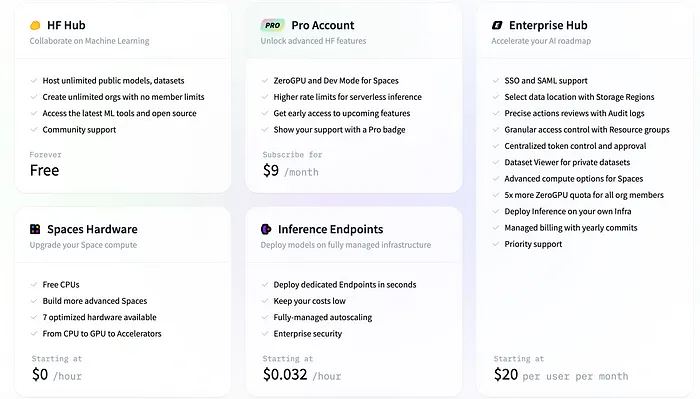Open-core business strategy @ Hugging Face, AKA ‘GitHub for AI Models’ #
Initially conceived as an AI-powered chatbot for teenagers, Hugging Face pivoted towards democratizing machine learning (ML) models and building an open-source ecosystem. Today, it operates as a community-driven AI company, hosting a repository of state-of-the-art ML models and tools akin to “GitHub for AI.“
Hugging Face has raised $395 million (Series D), valuing the company at $4 billion. It plans to go public in the future, aiming to be the first company with an emoji ticker on NASDAQ. Its trajectory reflects the growing demand for AI model sharing, collaboration, and enterprise integration, mirroring GitHub’s transformation from a code-hosting service into a DevOps powerhouse. Hugging Face employs an open-core business model.
In this article, I examine the similarities between Hugging Face and GitHub, two businesses that facilitate collaboration among their target users (data scientists and developers, respectively). Both utilize an open-core business model and have developed enterprise offerings that create significant platform lock-in.
The Open-Core Business Model #
Hugging Face’s success, much like GitHub’s, is rooted in an open-core approach. Its Transformers library and Model Hub are freely available, allowing researchers, students, and companies to access pre-trained models and build on them without cost. This mirrors GitHub’s strategy of providing free public repositories, which have become the foundation for open-source software development.
However, while the core platform remains free, both companies have found ways to monetize at scale. GitHub generates revenue through private repositories, enterprise collaboration tools, and DevOps automation services, including GitHub Actions. Hugging Face, meanwhile, earns revenue through compute services, API-based model inference, AutoTrain, and enterprise AI hosting.

Collaboration as the Engine of Growth #
One of GitHub’s key advantages is its ability to facilitate collaboration at scale. Open-source projects thrive because of GitHub’s version control, issue tracking, and pull request systems, making it effortless for developers to contribute.
Hugging Face mirrors this in AI, but with models instead of code. The Hugging Face Hub acts as a repository for pre-trained models, datasets, and AI pipelines, allowing ML practitioners to reuse, fine-tune, and build on others’ work. The impact has been significant — its Transformers library has been forked 8x more than competing AI platforms like H2O.ai.
This community-driven approach fuels platform stickiness. Much like GitHub, the more models hosted on Hugging Face, the harder it becomes for enterprises and researchers to move elsewhere.
Similar lock-in enterprise play #
GitHub’s enterprise strategy involves offering features tailored to large organizations — enhanced security, compliance, and workflow automation tools — making it indispensable for companies managing complex codebases. Hugging Face has followed a parallel path, targeting AI-driven enterprises that need private model hosting, compliance, and scalable machine learning infrastructure.
Both platforms use pricing and features to drive adoption, create lock-in, and monetize growth. GitHub integrates directly into developer workflows, ensuring organizations rely on it for their entire software development lifecycle. Hugging Face integrates into AI pipelines, handling model training, versioning, inference, and deployment, making it deeply embedded in ML workflows.
These enterprise plays ensure long-term revenue streams and retention, as switching costs become prohibitively high.
Simplifying productionalization #
GitHub’s CI/CD tools (GitHub Actions) enable developers to seamlessly deploy code. Hugging Face takes a similar approach with its Inference API, which allows developers to integrate AI models into production without managing ML infrastructure. This serverless approach to AI echoes GitHub’s role in automating cloud deployments.
The goal is the same: make production workflows seamless, so users remain locked into the ecosystem.
Projects (Spaces, Pages) #
Hugging Face’s Spaces, which allow developers to deploy interactive AI applications using Streamlit, Gradio, and other UI tools, serve as another strategic parallel to GitHub Pages, which hosts static websites and web apps.
Both products extend their platforms from development and collaboration to public-facing application deployment. This shift moves Hugging Face beyond model hosting, making it a platform for AI-powered applications, much like GitHub became a home for developer tools beyond just version control.
Future Opportunities #
GitHub has leveraged GitHub Sponsors to allow developers to fund open-source projects. Hugging Face could adopt a similar model, enabling users to fund the development of high-value AI models. It also aligns incentives for Hugging Face to make more robust open-source models than proprietary ones.
Another emerging opportunity is a paid model marketplace, where developers can sell fine-tuned AI models. This might be harder since GitHub seems to have a head start here with GitHub Marketplace.
Nonetheless, as AI development converges with software engineering, Hugging Face has room to evolve into a broader AI infrastructure platform, further mirroring GitHub’s role in DevOps.
I don’t think GitHub and Hugging Face have to be separate ecosystems. By leveraging automation, creating unified issue tracking, and implementing cross-platform workflows, Hugging Face can build a bridge between the two platforms.
This article was originally published on Medium as part of the BoFOSS publication.
